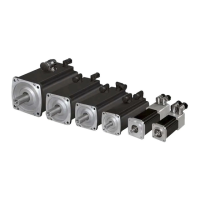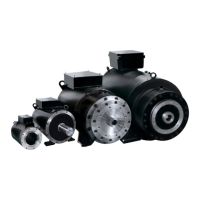TAM 00699 14
DSD2 045 – 132 04/2018
Three-phase synchronous motor English
the permitted radial forces according to the operating characteristics in the technical documentation
that accompanies the product are not exceeded (if necessary, contact Baumüller for clarification).The
motor manufacturer must always be contacted if axial forces occur.
the brake (optional) can be released once the operating voltage has been applied (audible operating
noise).
the rotor rotates smoothly without a scraping sound.
On motors with a brake fitted, release the brake beforehand.
the design of the motor and encoder cables – and of the fan cable (if available), complies with the
details in the technical documentation that accompanies the product.
the output and input elements are secured.
the complete cooling circuit is leak proof and fully functional and protected against any foreign
objects falling into it.
4 Electrical connections
Important notes:
All work must be carried out by specially trained personnel.
Work must only be carried out when the system is electrically isolated and secured
against unintentional restarting (also auxiliary circuits).
Work must only be carried out once the motor has come to a standstill.
In the case of three-phase synchronous motors with permanent magnet excitation,
voltages of > 60 V can occur at the motor contacts with the rotor running.
Regulations for working in electrical plants must be observed!
Attention! The safety regulations for work on electrotechnical systems in accordance with
EN 50110-1 must be followed:
Isolate
Secure against unintentional restarting
Verify safe isolation from the supply
Earthing and short-circuiting
Safeguard or cover adjacent live parts
The electric motor must be operated by a correspondingly designed converter. A
direct connection to the three-phase mains can destroy the motor.
Ensure that the phase sequence and the pin assignment are correct!
Electrical connections, protective conductor connections, and screen connections
(when using screened cables) must be permanently secure!
Never touch the contacts of the encoder or thermal sensor with your hands or with
tools which are or may be electrostatically charged. The encoder and the thermal
sensors are electrostatically sensitive components.
Electrical installation:
• The person setting up the system is responsible for correct electrical installation.
• The motor data on the type plate must be observed.
• Connection cables and connectors must be correctly rated for the voltages and currents and must be
suitable for the method of installation employed.
• The motor and the modules (brake, encoder, fan etc.) must be connected in accordance with the
details on the wiring diagrams (see enclosed wiring diagrams and Section 8).
• Screened power and encoder cables must be used to protect against electromagnetic EMC
interference from motor cables and their effects on the encoder and control systems. Please refer to
the EMC notes provided by the supplier of the converter.

